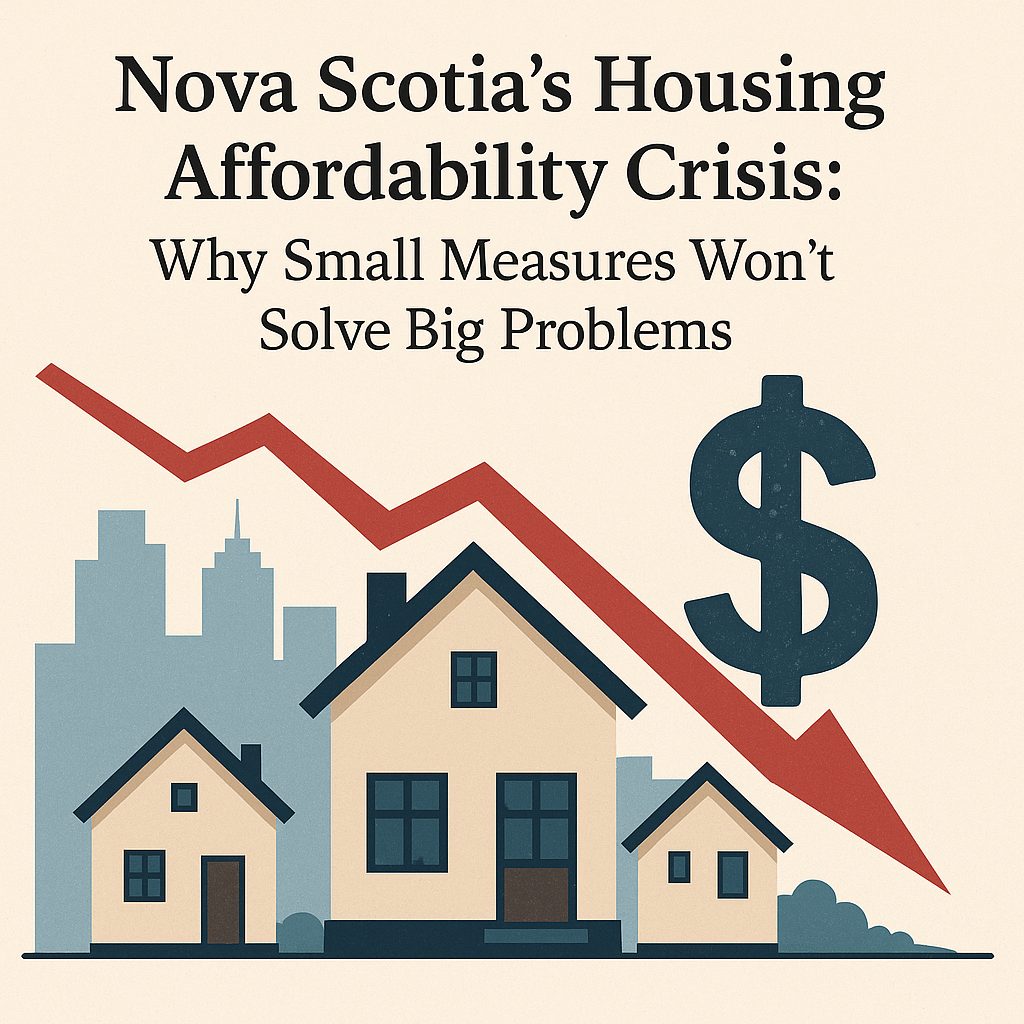Nova Scotia’s Housing Affordability Crisis: Why Small Measures Won’t Solve Big Problems
When Ontario announced its plan to eliminate the provincial portion of HST for first-time home buyers, potentially delivering up to $80,000 in savings, it sent ripples across Canadian real estate markets. But even as industry experts debate whether this move will truly ease affordability or stimulate construction, one question emerges for Nova Scotians: are we doing enough?
The short answer is no.
The Stark Reality of Nova Scotia’s Housing Market
Between 2021 and 2025, Nova Scotia experienced one of the most significant growth periods in the province’s recent real estate history, with average home prices increasing by 53.1%. To put that in perspective, homes that cost $315,000 to $370,000 in 2021 now average between $440,000 and $500,000.
In Halifax, the situation is even more acute, with average home prices reaching $623,008 by December 2024. For young professionals, growing families, and essential workers, homeownership has shifted from challenging to nearly impossible.
A Tale of Two Provinces
Let’s compare what’s on the table:
Ontario’s Proposed Relief:
- Full 8% provincial HST rebate on new homes up to $1 million
- Saves first-time buyers up to $80,000
- Partial rebates on homes valued up to $1.5 million
- Combined with federal relief, total potential savings of $130,000
Nova Scotia’s Current Support:
- $3,000 maximum rebate (18.75% of provincial HST) on newly built homes only
- Down payment assistance up to $25,000 (as an interest-free loan, not a grant)
- Home Buyers’ Tax Credit worth up to $750
The gap is staggering. While Ontario offers grants worth up to $80,000, Nova Scotia provides $3,750 in direct relief ($3,000 rebate + $750 tax credit) plus a loan that must be repaid.
Why Incremental Solutions Are Failing
The Math Doesn’t Add Up
Consider a typical first-time buyer scenario in Nova Scotia:
With the average Nova Scotia home price at $488,760 as of June 2025, buyers face:
- Down payment (5% minimum): $24,438
- Closing costs: ~$8,000-$12,000
- HST on new builds (15%): $73,314
- Current provincial rebate: -$3,000
- Net tax burden: $70,314
Even with the $25,000 down payment loan, buyers still need roughly $40,000-$45,000 in cash plus approval for a $460,000+ mortgage. With mortgage rates still relatively high compared to pre-pandemic levels, the borrowing environment remains the biggest factor causing first-time buyers to wait on the sidelines.
The Supply Problem Demands Urgent Action
Here’s the most sobering reality: According to CMHC, Nova Scotia needs to more than double its pace of housing construction starts for the next decade to restore affordability to pre-pandemic levels.
While the province’s housing plan represents a $1.7-billion investment over five years and housing starts were up 176% from July 2024 to July 2025, we’re still playing catch-up. If construction accelerates as planned, CMHC estimates home prices could fall from an average of about $511,000 to under $406,000 by the end of 2035—but that’s a decade away.
What Bold Action Actually Looks Like
If Nova Scotia is serious about housing affordability, here’s what needs to happen:
1. Meaningful Tax Relief Now
Ontario’s approach shows what’s possible. Nova Scotia should:
- Quadruple the HST rebate from $3,000 to at least $12,000-$15,000
- Remove the “new builds only” restriction to help buyers across all market segments
- Extend eligibility to homes up to $650,000 (closer to actual market prices)
- Phase out gradually for homes between $650,000-$850,000
This wouldn’t fully match Ontario’s relief, but it would signal that the province understands the scale of the problem.
2. Transform Down Payment Assistance
The current program is helpful but insufficient. Improvements should include:
- Increase the maximum from $25,000 to $40,000
- Raise the income threshold from $145,000 to $200,000 for dual-income households
- Extend repayment from 10 to 20 years to reduce monthly burden
- Offer partial forgiveness (e.g., 20% forgiven if buyer stays in NS for 10 years)
3. Attack the Supply Crisis from Multiple Angles
Industry experts note that in metro regions, there is low inventory for homes under $1 million, except for small condos. The province needs to:
- Fast-track approvals for multi-unit residential buildings (6-12 months maximum)
- Provide density bonuses for developments including affordable units
- Invest heavily in non-market housing through government and non-profit providers
- Convert underused commercial properties to residential use with tax incentives
- Support modular and prefab construction to reduce building costs
4. Create Innovative Financing Solutions
Since the province can’t control federal interest rates, it should:
- Subsidize mortgage rates for first-time buyers (e.g., province pays 1.5% of interest for first 5 years)
- Partner with credit unions to offer 30- or 35-year amortizations for qualified buyers
- Provide graduated payment mortgages that start lower and increase with expected income growth
- Offer property tax deferrals for first 3-5 years of ownership
5. Target the “Missing Middle”
Transaction volumes have decreased significantly from 2021’s exceptional levels, indicating a market finding equilibrium at higher price points. We need housing that fills the gap between condos and detached homes:
- Duplexes, triplexes, and fourplexes in residential neighborhoods
- Townhome developments with shared-equity models
- Co-housing communities that reduce per-unit land costs
- Laneway houses and garden suites to maximize existing lots
The Cost of Inaction
What happens if Nova Scotia continues with modest, incremental measures?
Scenario 1: Status Quo
- Average home prices continue rising year-over-year
- Young professionals and families increasingly priced out
- Brain drain accelerates as talent moves to more affordable markets
- Essential workers (teachers, nurses, tradespeople) can’t afford to live where they work
- Rental market remains tight, pushing more people toward precarious housing
Scenario 2: Bold Action
- Immediate relief through tax rebates makes homeownership feasible for thousands
- Increased supply gradually moderates price growth
- Diverse housing options emerge at multiple price points
- Population growth continues as people see NS as attainable
- Economic growth sustained through stable, diverse communities
Learning the Right Lessons from Ontario
Ontario’s HST relief proposal has sparked debate. Critics argue it’s “a drop in the bucket” that won’t address fundamental supply issues. They’re partly right—tax relief alone won’t solve the housing crisis.
But here’s what critics miss: struggling buyers need help today, not in 2035.
The most effective strategy combines immediate demand-side relief with aggressive supply-side solutions. Yes, we need to double housing starts. Yes, we need more diverse housing types. Yes, we need better zoning and faster approvals.
But we also need to help the nurse, teacher, and tradesperson who are ready to buy today but can’t bridge the affordability gap.
A Call for Proportional Response
Nova Scotia’s housing plan has already paved the way for 68,841 new units, exceeding its first-year target of 41,200. This progress is commendable and shows the province is taking housing seriously.
But when home prices rise 53% in four years, a $3,000 rebate isn’t a proportional response—it’s a band-aid on a broken bone.
Nova Scotia has an opportunity to lead, not follow. Instead of watching Ontario experiment with bold tax relief, the province could implement its own comprehensive affordability package that addresses both immediate needs and long-term supply.
The question isn’t whether we can afford to do more. It’s whether we can afford not to.
What’s at stake isn’t just housing—it’s the future of who gets to call Nova Scotia home.

 Facebook
Facebook
 X
X
 Pinterest
Pinterest
 Copy Link
Copy Link

